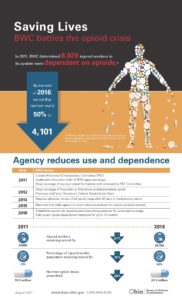America is in the throes of an opioid epidemic that is so far-reaching and destructive it has been declared a public health emergency. Unfortunately, much this epidemic is rooted in prescription pain killers and the workplace can be ground-zero for the deadly spiral of opioid addiction. Where there are workplace injuries, there is generally pain and the prescribing of pain killers.
 Our Ohio Bureau of Workers’ Compensation (BWC) has deployed several measures over the last six years to control the role that workers’ compensation plays in this crisis. In 2011, BWC determined 8,029 injured workers in its system were dependent on opioids. By 2016 they had cut that figure nearly 50 percent to 4,101 by managing how many pain meds were being prescribed.
Our Ohio Bureau of Workers’ Compensation (BWC) has deployed several measures over the last six years to control the role that workers’ compensation plays in this crisis. In 2011, BWC determined 8,029 injured workers in its system were dependent on opioids. By 2016 they had cut that figure nearly 50 percent to 4,101 by managing how many pain meds were being prescribed.
As an employer, are you doing all you can to protect your employees and bottom line? Are you testing for the drugs of abuse that have been at the root of this problem? Unless you have negotiated with your drug testing vendor to test for these drugs, you probably are not.
Many employers assume they are testing for the current drugs of concern because on a test result report they see “opiates” listed as one of the included drug categories. This is a long-standing testing category for the U.S. Department of Transportation to Ohio’s Drug-Free Safety Program and many more. It refers to organic substances that come from the poppy plant, including illicit drugs heroin and opium and prescription drugs codeine and morphine. That means synthetic meds like hydrocodone (e.g., Vicodin® and Lortab®), hydromorphone (e.g., Dilaudid®) and oxycodone (e.g., OxyContin® and Percocet®), that have given rise to our current problem, are not included.
Is it time to extend the reach of your drug testing program to include these highly abused medications? We encourage you to get a written list of exactly what you are testing for and expand it if necessary. Negotiate with your vendor for what’s called an “expanded opioid panel.”
A fear that employers might have about looking for more painkillers in their drug tests is that employees will test positive if they are legitimately and safely taking prescription meds. If you are using best-practice testing, there is a Medical Review Officer (MRO) in your drug testing process (and there really should be). With that oversight, an employee will not test positive result if they can provide acceptable documentation or verification of that prescription. Best-practice drug testing does work to protect the rights of employees — including the appropriate use of prescription medications.
Aside from the excellent strides our workers’ compensation system has made in Ohio, employers can take an active role in protecting their workplaces from this insidious foe.
Check out this three-and-a-half-minute video to learn more.
